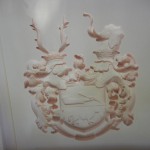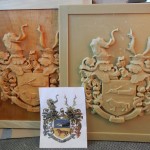- Silicone Rubber mold (believe it or not this is in reverse)
- Left – original woodcarving; Right – Resin casting; center – 8-1/2 x 11 copy of original color coat of arms
I unwrapped my Christmas present – and Santa was good to me! Only a few little air bubbles, but no big deal. The silicone rubber mold came off easily. The first photo is difficult to picture, but it is in reverse (i.e. the carving is set into the mold rather than sticking out). Sometimes the shadows are very deceiving.
I opened the 2 containers of resin (mixed 1 to 1 equally) and started to stir. Since there was a type of filler (maybe silicone? It was heavy – not micro-baloon) mixed in, it was like stirring peanut butter where the oil had separated, only worse. It took about an hour to stir each container by hand and get the thick sludge at the bottom mixed in. I ended up mixing about 1-3/4 gallon of resin (this was also nerve wracking, as it has 8 minutes of mixing time before it starts to heat up and harden). I had to do it in 4 separate batches because my container wasn’t large enough, and I also didn’t estimate the amount I needed accurately. By the time I was mixing the final batch, the first one that I poured was beginning to harden. It really doesn’t make that much of a difference, except that the back surface was a little uneven because of this. I am pretty sure I can just put a belt sander to it and smooth this.
The best way to figure out the correct amount to mix (which I did not do) is to either pour water (or sand) into the mold first, pour it out into a separate containter, and measure the volume. It would have been difficult with water, as I’m sure half of the water would have ended up on the floor when I tried to pour it off into a separate container. It would have just been too awkward with the size and shape of it. Sand would have been better and more controllable, but still awkward. So… I just jumped right in and hoped for the best.
Make sure before you pour your resin that all water is dried or sand is washed away.
After pouring the resin, I waited about 3 hours and – a successful resin casting! Some slight discoloration from the “peanut buttery” part of resin still not mixed through, but it didn’t change the surface texture.
I still have to make 2 more resin castings, and may try another product – my hand is still aching from the peanut butter stirring.
Stephanie Poe, an very talented faux finishing artist, will be painting both the original woodcarving and resin castings to match the original color of the coat of arms.
As I mentioned earlier, the wooden one will stay indoors, and the resin will be for outside on their call box at the end of the driveway. Once it is painted, the resin should not break down in the SC sun. It may need to be touched up every once in a while, but will definitely last longer than if the wooden one were outdoors.



Mary, this is very interesting and something I have wanted to learn/do for years, (but was too scared). We must talk about this.
Cheers, Ron
Hey Ron, good to hear from you. Next time you are in town escaping the Canadian snow, give me a call and you can help me make a mess!
I have two carved figurines, and neither I nor the person I got them from can tell if they are wood or resin/polymer. How can one tell for certain? Thank you.
I guess my first thing would be to go to an area on the figurine that is not visible (such as the bottom surface) and scratch it through the paint to see whether you can see wood crain or not. I would NOT do this if it is an antique and if it will reduce the value. You may want to be on the safe side and take it to an antique dealer or appraiser and they may be able to let you know exactly what it is without damaging it. Sorry I can’t help you more with this. Good luck!